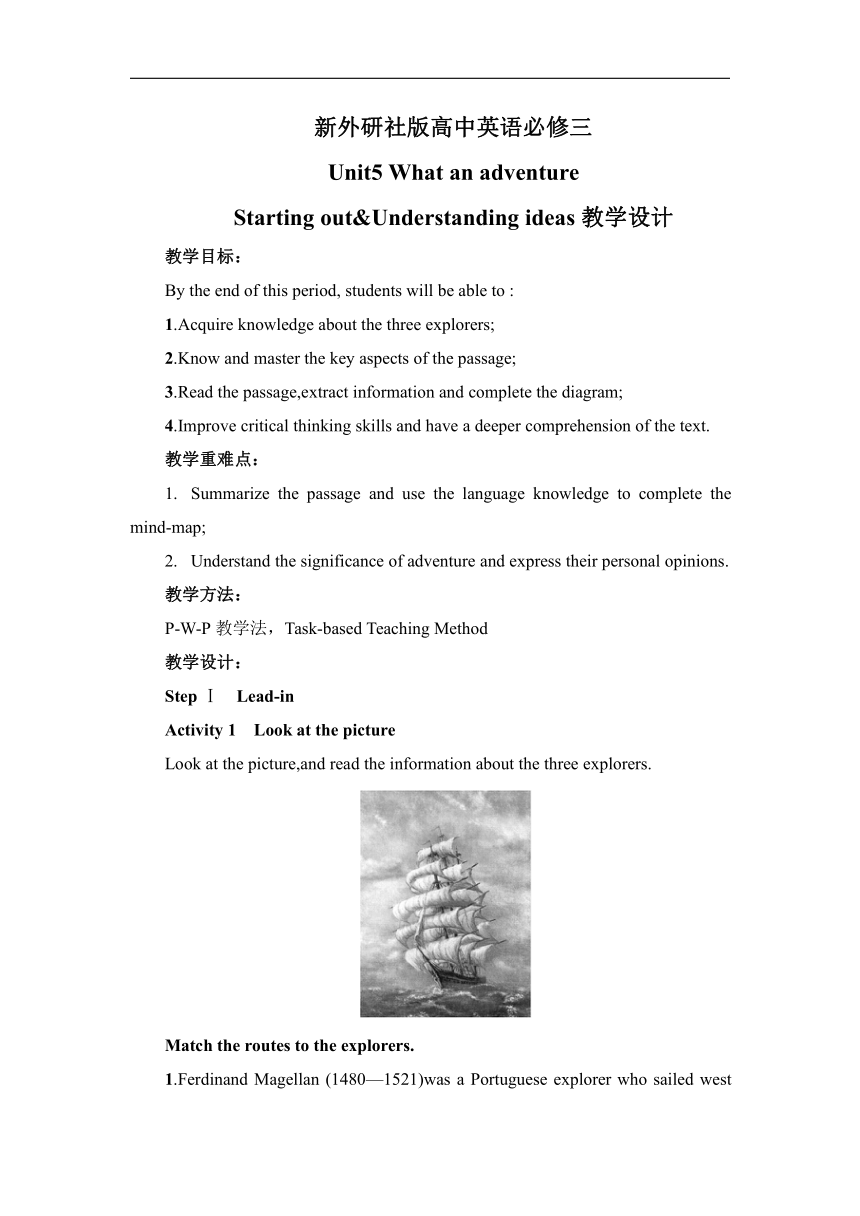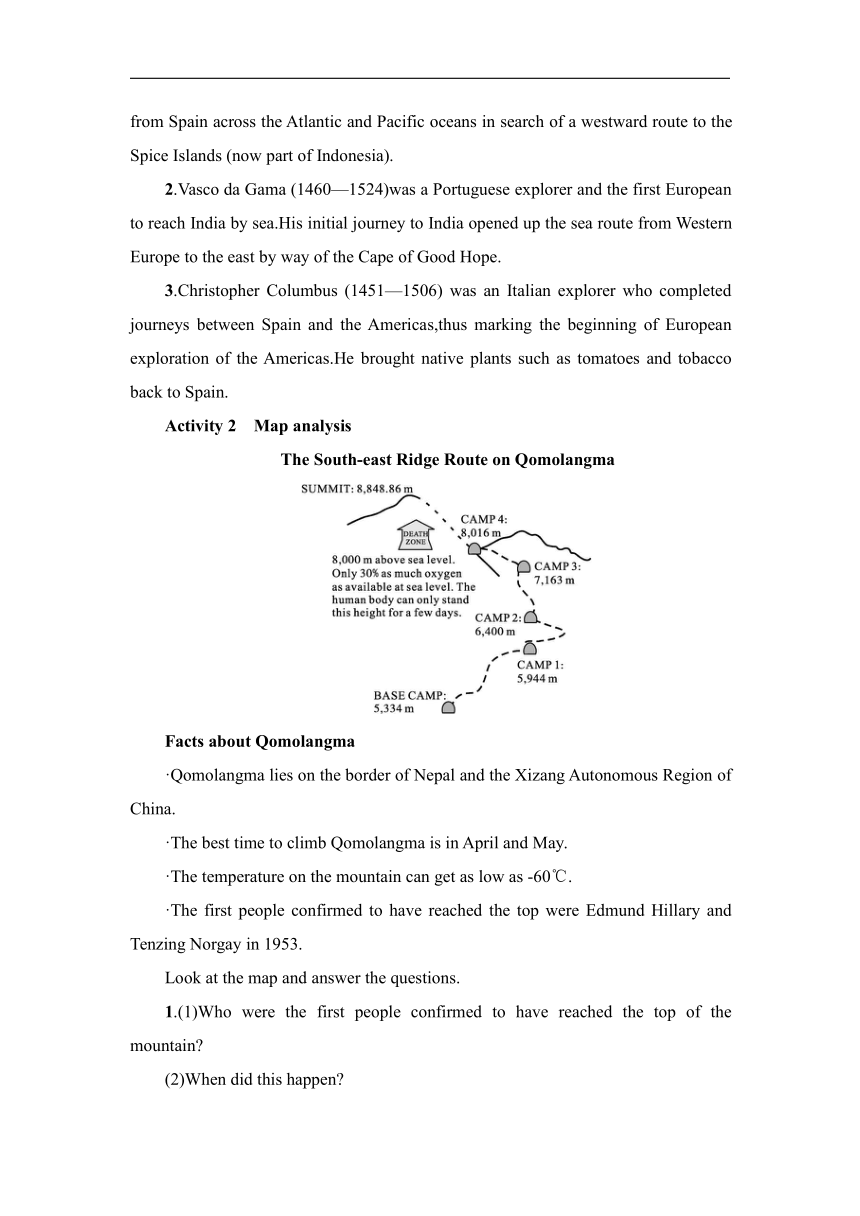外研版(2019)必修第三册Unit 5 What an Adventure! Starting out & Understanding ideas 教学设计
文档属性
| 名称 | 外研版(2019)必修第三册Unit 5 What an Adventure! Starting out & Understanding ideas 教学设计 |  | |
| 格式 | docx | ||
| 文件大小 | 182.9KB | ||
| 资源类型 | 教案 | ||
| 版本资源 | 外研版(2019) | ||
| 科目 | 英语 | ||
| 更新时间 | 2024-03-07 14:56:27 | ||
图片预览


文档简介
新外研社版高中英语必修三
Unit5 What an adventure
Starting out&Understanding ideas教学设计
教学目标:
By the end of this period, students will be able to :
1.Acquire knowledge about the three explorers;
2.Know and master the key aspects of the passage;
3.Read the passage,extract information and complete the diagram;
4.Improve critical thinking skills and have a deeper comprehension of the text.
教学重难点:
Summarize the passage and use the language knowledge to complete the mind-map;
Understand the significance of adventure and express their personal opinions.
教学方法:
W-P教学法,Task-based Teaching Method
教学设计:
Step Ⅰ Lead-in
Activity 1 Look at the picture
Look at the picture,and read the information about the three explorers.
Match the routes to the explorers.
1.Ferdinand Magellan (1480—1521)was a Portuguese explorer who sailed west from Spain across the Atlantic and Pacific oceans in search of a westward route to the Spice Islands (now part of Indonesia).
2.Vasco da Gama (1460—1524)was a Portuguese explorer and the first European to reach India by sea.His initial journey to India opened up the sea route from Western Europe to the east by way of the Cape of Good Hope.
3.Christopher Columbus (1451—1506) was an Italian explorer who completed journeys between Spain and the Americas,thus marking the beginning of European exploration of the Americas.He brought native plants such as tomatoes and tobacco back to Spain.
Activity 2 Map analysis
The South-east Ridge Route on Qomolangma
Facts about Qomolangma
·Qomolangma lies on the border of Nepal and the Xizang Autonomous Region of China.
·The best time to climb Qomolangma is in April and May.
·The temperature on the mountain can get as low as -60℃.
·The first people confirmed to have reached the top were Edmund Hillary and Tenzing Norgay in 1953.
Look at the map and answer the questions.
1.(1)Who were the first people confirmed to have reached the top of the mountain
(2)When did this happen
2.Why do you think the climbers need so many camps along the route
3.What else do you know about Qomolangma Share the information with the class.
Suggested answers:
Activity 1
1-b 2-c 3-a
Activity 2
1.(1)Edmund Hillary and Tenzing Norgay.
(2)In 1953.
2.It is such a long way that it cannot be done within one day.The climbers need these camps for a rest and adapt themselves to the environment.
3.Students’ own answers.
Step Ⅱ While -reading
Activity 1 Read for the main idea
Choose the author’s purpose in writing the passage.
Activity 2 Complete the paragraphs
Complete the paragraphs with expressions from the passage.
Why Do People Climb Qomolangma
Scientific reasons
Risk-taking may be part of 6. .People who are more likely to 7. have “Type T” personalities.Research also suggests that our desire to seek risks can be connected to how much we expect to 8. .
Suggested answers:
Activity 1
2
Activity 2
1.sheer joy 2.enjoy life 3.important and unique 4.look deep inside 5.mental toughness 6.human nature 7.take risks 8.benefit from the result
Step Ⅲ Post-reading
Go through the questions and think about them individually,then discuss the questions in groups and share your answers with the class.
Questions:
If you were given the chance,would you like to climb Qomolangma Why or why not
Suggested answers:
Students’ own answers.
Step Ⅳ Homework
Please share your personal adventurous experiences with your classmates.
Students’ own answers.
评价量规
学习目标 目标达成评价等级
A B C D
Acquire knowledge about the three explorers;
Know and master the key aspects of the passage;
Read the passage,extract information and complete the diagram;
Improve critical thinking skills and have a deeper comprehension of the text.
教学反思
本节阅读课重点在于引导学生提升阅读技巧,并进行更深层次的思考。同时,本节课通过图片分析的方式引出单元主题。文章类型为专栏文章,通过举例和引用几位探险家和心理学家说的话,分析探险家探险的“天性”和探险活动的价值。学生通过对课文的学习能够挖掘有关探险的价值和意义,形成辩证性思考的习惯。
Unit5 What an adventure
Starting out&Understanding ideas教学设计
教学目标:
By the end of this period, students will be able to :
1.Acquire knowledge about the three explorers;
2.Know and master the key aspects of the passage;
3.Read the passage,extract information and complete the diagram;
4.Improve critical thinking skills and have a deeper comprehension of the text.
教学重难点:
Summarize the passage and use the language knowledge to complete the mind-map;
Understand the significance of adventure and express their personal opinions.
教学方法:
W-P教学法,Task-based Teaching Method
教学设计:
Step Ⅰ Lead-in
Activity 1 Look at the picture
Look at the picture,and read the information about the three explorers.
Match the routes to the explorers.
1.Ferdinand Magellan (1480—1521)was a Portuguese explorer who sailed west from Spain across the Atlantic and Pacific oceans in search of a westward route to the Spice Islands (now part of Indonesia).
2.Vasco da Gama (1460—1524)was a Portuguese explorer and the first European to reach India by sea.His initial journey to India opened up the sea route from Western Europe to the east by way of the Cape of Good Hope.
3.Christopher Columbus (1451—1506) was an Italian explorer who completed journeys between Spain and the Americas,thus marking the beginning of European exploration of the Americas.He brought native plants such as tomatoes and tobacco back to Spain.
Activity 2 Map analysis
The South-east Ridge Route on Qomolangma
Facts about Qomolangma
·Qomolangma lies on the border of Nepal and the Xizang Autonomous Region of China.
·The best time to climb Qomolangma is in April and May.
·The temperature on the mountain can get as low as -60℃.
·The first people confirmed to have reached the top were Edmund Hillary and Tenzing Norgay in 1953.
Look at the map and answer the questions.
1.(1)Who were the first people confirmed to have reached the top of the mountain
(2)When did this happen
2.Why do you think the climbers need so many camps along the route
3.What else do you know about Qomolangma Share the information with the class.
Suggested answers:
Activity 1
1-b 2-c 3-a
Activity 2
1.(1)Edmund Hillary and Tenzing Norgay.
(2)In 1953.
2.It is such a long way that it cannot be done within one day.The climbers need these camps for a rest and adapt themselves to the environment.
3.Students’ own answers.
Step Ⅱ While -reading
Activity 1 Read for the main idea
Choose the author’s purpose in writing the passage.
Activity 2 Complete the paragraphs
Complete the paragraphs with expressions from the passage.
Why Do People Climb Qomolangma
Scientific reasons
Risk-taking may be part of 6. .People who are more likely to 7. have “Type T” personalities.Research also suggests that our desire to seek risks can be connected to how much we expect to 8. .
Suggested answers:
Activity 1
2
Activity 2
1.sheer joy 2.enjoy life 3.important and unique 4.look deep inside 5.mental toughness 6.human nature 7.take risks 8.benefit from the result
Step Ⅲ Post-reading
Go through the questions and think about them individually,then discuss the questions in groups and share your answers with the class.
Questions:
If you were given the chance,would you like to climb Qomolangma Why or why not
Suggested answers:
Students’ own answers.
Step Ⅳ Homework
Please share your personal adventurous experiences with your classmates.
Students’ own answers.
评价量规
学习目标 目标达成评价等级
A B C D
Acquire knowledge about the three explorers;
Know and master the key aspects of the passage;
Read the passage,extract information and complete the diagram;
Improve critical thinking skills and have a deeper comprehension of the text.
教学反思
本节阅读课重点在于引导学生提升阅读技巧,并进行更深层次的思考。同时,本节课通过图片分析的方式引出单元主题。文章类型为专栏文章,通过举例和引用几位探险家和心理学家说的话,分析探险家探险的“天性”和探险活动的价值。学生通过对课文的学习能够挖掘有关探险的价值和意义,形成辩证性思考的习惯。
